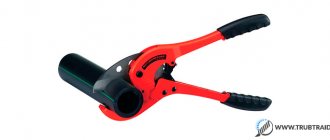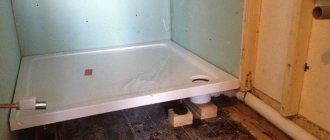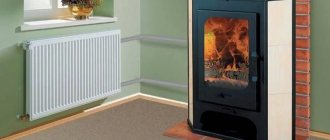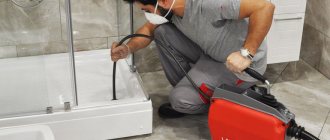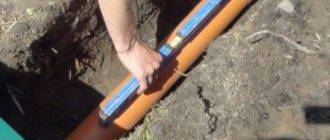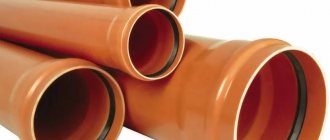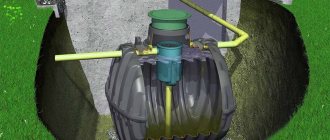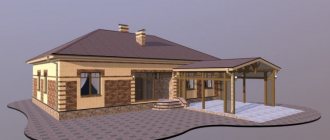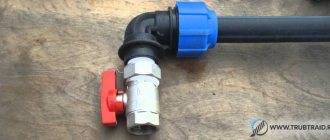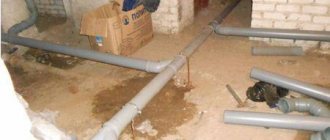Published: 02/3/2018 Category: Materials and technologies Views: 3295
Sewer pipes
Pipes are the basis of the sewer system. It depends on them how durable the sewage system will be. After all, no one wants to change or repair it every two or three years. If you buy good pipes, the sewer system will last for decades. In the article we will tell you how and which pipes to choose.
Three factors play a role in pipe selection: material, pipe location, and fittings. The material of the pipes determines their reliability and durability.
Depending on the location: for external and internal sewerage, the requirements differ. External sewerage - underground on the street. The inner half goes underground and half comes from toilets, sinks and showers throughout the house. The availability and range of fittings have a lesser influence on the choice of pipes, but they determine the ease of installation of the sewer system. Let's first consider two types of sewerage: internal and external.
External sewerage
Example of external sewerage
The external sewer system runs underground on the street and carries wastewater to the septic tank. Pipes for external sewerage can withstand static and dynamic loads:
- soil pressure,
- movement of people
- traffic,
- groundwater movement,
- temperature changes,
- humid environment,
- aggressive environments.
Dynamic loads. These are all variable loads: movement of cars and people, movement of groundwater. Pipes with high ring stiffness can withstand dynamic loads well.
Static loads. These are loads that constantly put pressure on the pipeline: soil pressure. Products with high ring rigidity also resist pressure well. Static loads also include others; we will consider them separately.
Temperature changes. The most dangerous are cold snaps, since many pipes can withstand 30-degree heat, but cannot cope with 30-degree frost. Therefore, sewerage pipes are placed below the freezing level of the soil and are made frost-resistant. The freezing level is different for each region. For the Leningrad region, for example, 1.16−1.71 meters - depending on the type of soil.
Wet environments. High humidity in spring and autumn destroys ferrous metals without anti-corrosion coating and some other materials. Groundwater movement can dislodge the pipeline if it is not installed correctly.
Aggressive environments. These are acids, salts and alkalis that are found in soil and wastewater.
Therefore, pipes inside and outside must be resistant to various substances.
Technical requirements for the sewer pipeline
In the general sewer system in any house there are two interconnected parts - external and internal. For each of them, pipes must be selected taking into account the requirements of GOST and SNiP. Let's talk about the differences between internal and external sewerage pipes.
External sewerage pipeline
The external sewer system has its own characteristics, so it is important that it is highly resistant to both static and dynamic loads. In other words, such products must perfectly withstand mechanical stress, deformations that may occur when vehicles drive, people move, and also freely withstand the mass of soil that is laid on top. It is with these parameters in mind that it is worth determining which pipe for sewerage into the ground should be used. All connections of pipeline parts must be as strong as possible and ensure complete absence of breaks so that the integrity of the pipeline is not compromised under any circumstances.
According to SNiP 2.04.03-85, in the external sewerage pipeline, pipes must lie below the level of soil freezing determined by specialists. It is important to consider that it differs in different parts of the country. In most cases, for a private house it is located at a depth of 0.5-2 meters. This indicator determines which pipes are best to choose for sewerage in a particular case.
In places located at the intersection with a road where cars regularly pass, durable pipes are used for sewerage. They must cope well with high loads.
Internal sewerage pipeline
Pipes that can be used for indoor sewerage do not have to meet such high requirements for strength and reliability. As a rule, they are laid under various decorative elements, as well as directly in building structures. Regardless of the sewerage layout, it is not subjected to such high loads as external ones. However, when choosing which pipes for indoor sewerage are better, you should focus on the following characteristics:
- resistance to high or low temperatures, aggressive chemicals, pressure;
- a smooth surface from the inside that will not interfere with the free flow of wastewater;
- Possibility of connection with parts of external sewerage.
These requirements are specified in SNiP 2.04.01-85. In addition, another important factor is the ability to quickly and easily install, as well as replace the damaged section of the sewer system, if the need arises. Taking into account the listed requirements, many owners of private houses choose pipes made of polyethylene, which are convenient to work with, as well as metal-plastic ones.
Internal sewerage
Internal sewer outlet
Internal sewerage runs in the house itself and is connected to the external one under or through the foundation. For the internal pipeline, rigidity is not so important; the load on it is several times less. But other general requirements remain:
- durability,
- easy replacement,
- soundproofing,
- ease of installation,
- non-toxic,
- smoothness of the inner surface.
Durability. Nobody wants to change the pipeline every two or three years. Especially when there are materials with a service life of 50 years or more.
Easy replacement. To replace old sewers, major repairs are carried out. It is better if the pipeline can be easily replaced in case of breakdown.
Soundproofing. Pipes for internal sewerage must isolate the sounds of sewage movement from the inhabitants of the house.
Ease of installation. Some plastic pipes can be easily installed by a non-professional. The easier the installation, the faster the sewer construction takes place.
Non-toxic. Pipes must be non-toxic and not release toxic substances upon contact with wastewater.
Smooth inner surface. The sewer will silt and become clogged if the inner walls of the pipes are rough.
In addition, the internal and external water pipes must be easily connected to each other. If they do not connect well, the joint between them will become clogged or leak. This is especially important when partially replacing the pipeline.
Go ahead. Let's consider which pipes are most suitable for sewer systems :
- PVC pipes,
- PE pipes,
- PP pipes,
- asbestos-cement,
- concrete,
- cast iron,
- ceramic.
Leading manufacturers of internal pipes
To select pipes for sewerage, it is necessary to compare the characteristics of the products of leading manufacturers of pipeline systems. The market leaders are Rehau, Wavin, Ostendorf, Politek.
Rehay Raupiano
The German company Rehau produces Raupiano Plus multilayer pipes. The outer layer of these pipes is made of vibration- and impact-resistant polypropylene. There is a mineral spacer in the middle. The smooth inner polypropylene layer is wear-resistant and corrosion-resistant. The joining of Raupiano Plus pipeline elements is based on socket joints. The O-rings of these connections guarantee tightness, vibration and shock resistance of the sewer network.
To attach Raupiano Plus system elements to building structures, noise-absorbing clamps are used, which reduce the degree of sound propagation throughout the building structures.
The design of Raupiano Plus sewer systems creates good sound insulation and reliable protection against leaks. Due to the flexibility of the system elements, floor and wall installation of utility networks is possible. The white color of the pipeline is combined with different room design options.
Sewage pipes from the manufacturer Rehay Raupiano.
The operating temperature range is from -10°C to +90°C with short-term increases to +95°C. Pipes are resistant to chemically aggressive substances (acids, alkalis). The service life of products declared by the manufacturer is at least 50 years.
To improve the fire resistance of sewers, it is recommended to install fire cuffs that block the spread of fire through the utility network (sensor response temperature +120°C).
Wavin
Wavin is a Dutch company with forty years of experience in the production of polymer products for water supply, sewerage, drainage and storm water systems, and is a leader in the European market. Wavin sewer pipes are characterized by resistance to high temperatures (operating temperature +75°C with short-term increases to +95°C), are available in standard sizes 32-110 mm, with a wall thickness of 2.6 mm, in white and gray colors.
Sewage pipes from Wavin.
Wavin QuickStream indoor drainage systems, made of low-density polyethylene, are characterized by high chemical resistance, heat resistance, vibration and impact resistance, as well as a leak-tight design.
Wavin Optima systems are represented by pipeline elements and fittings made of polyvinyl chloride with diameters of 50, 75 and 110 mm. These products are characterized by high heat resistance.
They have smooth internal walls, which prevents the formation of deposits. The minimum service life declared by the manufacturer is 50 years. Special air valves prevent the penetration of odors from the sewer into the room.
Wavin Asto sound-absorbing pipes have a wall thickness of 5.3 mm and a diameter of 110 mm. Thick walls trap noise inside the sewer network, and elastic additives in the polypropylene structure help absorb sound vibrations. In addition, Wavin Asto systems are characterized by high resistance to chemical reagents (acids, alkalis). Thermal stability of these systems is +90…+95°С.
Ostendorf HT
The German company Ostendorf produces pipes for internal sewage from flame-retardant polypropylene under the Ostendorf HT brand. The products can withstand temperatures up to +95°C, are characterized by chemical resistance, corrosion resistance, good sound insulation and smooth internal walls.
Ostendorf HT sewer systems are fire-resistant, equipped with fire protection and centimeter markings that simplify the laying of the sewer line. The company's product range includes pipes up to 3 m long with a cross-section of 50-200 mm.
Sewage pipe manufacturer Ostendorf HT.
PVC pipes
PVC or uPVC - polyvinyl chloride, a new polymer material. PVC pipes are lightweight, environmentally neutral and easy to install.
PVC sewer pipe
Advantages:
- long service life,
- no overgrowth,
- resistance to acids,
- wear resistance,
- ease.
Flaws:
- inoperability at temperatures below −10°C,
- deform (elongate) at temperatures above 60°C.
Gray PVC pipes are excellent for indoor sewerage , where they are used. Red PVC pipes for sewerage with hardness SN-4 and higher can be used for external pipelines. To connect, the pipes are inserted into each other: at one end of the pipe there is a socket with a rubber ring, and at the other there is a chamfer that is tightly inserted into this socket. The inner surface of PVC pipes is perfectly smooth, so they rarely become clogged or overgrown.
Such pipes should be buried deeply, otherwise they will freeze. Also, you should not drain liquids with a temperature above 60°C through them for more than a minute. For a short time they can withstand temperatures exceeding 95°C.
Installation nuances
There are a number of nuances in the installation of sewerage systems, which, if ignored, can result in not a good drainage and drainage system, but, in Russian speaking, large hemorrhoids. So I will list as much as possible:
- When cutting pipes, the cut must be strictly perpendicular to the axis and must be processed with sandpaper;
- The elements to be glued must be degreased;
- Fittings with a rubber seal must be coated with silicone sealant;
- The cross-section of the horizontal pipeline should not exceed the diameter of the sewer riser;
- In places where the pipeline turns, it is necessary to install revisions - cleaning holes with a cover;
- Horizontal connections must be made from angles and oblique tees;
- Sewerage is secured at intervals equal to 10 x pipe diameter;
- The slope of horizontal sections should not exceed 1-2cm/1m;9. The bell is positioned towards the moving liquid.
PE pipes KORSIS and KORSIS Eco
Polyethylene is another polymer. KORSIS and KORSIS Eco pipes are made of high-density polyethylene (HDP) and an external corrugated layer is added. It increases ring rigidity, so the products are suitable for external sewerage.
Polyethylene pipes KORSIS
Advantages:
- durability,
- ease,
- elasticity,
- frost resistance down to −60°C,
- resistance to acids and alkalis,
- soundproofing,
- polished inner surface.
Flaws:
- sensitivity to sunlight,
- maximum temperature of the transported substance: 80°C.
Pipes made of high-density polyethylene, unlike PVC, tolerate low temperatures. At the same time, they are also lightweight, elastic and more reliable for external pipelines.
sells polymer pipes made of PVC and high-density polyethylene. SIS is the official distributor of the Poliplastik Group, a manufacturer of plastic pipes for sewerage, water supply, and heating. SIS sells products from the Polyplastic Group at prices from the manufacturer, and also helps you choose material for pipelines.
Technology for the production of pipe products for sewer systems
Extrusion is a method used for the manufacture of polyethylene pipes for external sewerage. This process looks like this:
Raw materials are fed into the extruder in granules, heated, plasticized and extruded from the head (pipe direct-flow). The material is continuously fed to the calibrating nozzle using a screw. Calibration occurs according to the outer diameter.
Compressed air is supplied inside the workpiece, inflating the pipe to the required diameter. The pipe is formed using a template matrix. It is necessary to coordinate the speed of material supply with the speed of movement after removal from the head. Using the water supply system, the polyethylene pipe is cooled. Rapid cooling can lead to residual stresses and uneven shrinkage, so the thermophysical properties of the feedstock are taken into account. Pipe up to 50 mm is wound into a coil, and larger pipes are cut into pieces of a given length with a circular saw moving along with the finished product. Labeling and packaging of finished products (coils or stacks).
Workshop for the production of polyethylene pipes
PP pipes
Polypropylene or PP pipes are also a new plastic building material with high strength values.
Polypropylene pipe for internal sewerage
Advantages:
- resistance to high and low temperatures,
- durability,
- ease,
- resistance to acids and alkalis,
- strength,
- ease of installation.
Flaws:
- instability to temperatures above 80°C.
The disadvantages of PP pipes relate to temperatures above 95°C and work with fire-hazardous objects. High temperatures have a bad effect on polypropylene, as well as on other polymer materials. In general, this material is excellent for any sewer systems. PP pipes are used for storm drainage, in private houses and apartment buildings due to their strength and wear resistance.
Conclusions and useful video on the topic
Video #1. Comparison of sewer pipes intended for the construction of external and internal sewage networks:
Video #2. Evaluation of the effectiveness of silent sewage systems Raupiano and Skolan:
From the point of view of financial benefit and practicality, polypropylene pipes are the optimal choice for organizing the internal part of the sewer system. The PP pipeline is affordable, easy to implement and guarantees uninterrupted long-term operation of the new engineering system.
Please write comments in the block below. Tell us about what pipes were used to repair the sewer system in an apartment or to install a system in a country house. Ask questions, share useful information, post photos related to the topic of the article.
Asbestos cement pipes
Asbestos-cement pipes are durable, which is why sewer pipelines are made from them. Cement and asbestos fiber are not destroyed by rot, acids or corrosion.
Asbestos-cement pipes in a storm sewer system
Advantages:
- cheapness,
- durability,
- resistance to acids, alkalis, aggressive environments,
- strength,
- ease of installation,
- resistance to clogging.
Flaws:
- fragility, instability to mechanical stress,
- harm to people and the environment.
Given their low cost and durability, asbestos-cement pipes are not the best option. They are more difficult to transport and install than polyplastic - the weight is higher than that of polymers. Also, asbestos cement crumbles at the edges, which is why the tightness is compromised if the connections are incorrect or of poor quality. The most dangerous, especially for internal connections: the environmental damage of asbestos concrete. Asbestos releases carcinogens; it is dangerous to work with and live near it.
Advantages and disadvantages of plastic products
There are several types of plastic pipes.
Option #1 - polyvinyl chloride pipes
Polyvinyl chloride was synthesized quite a long time ago, but it became widely used relatively recently. During the pipe production process, several raw materials are mixed and heated. The result is a plastic homogeneous mass. The composition of the material necessarily includes stabilizers, which firmly connect the molecules to each other, and plasticizers, which give the plastic certain properties. The heated mass is formed into a structure with given geometric dimensions. There are two types of polyvinyl chloride:
- Plasticized or PVC. It is characterized by increased elasticity, but has low strength. Not recommended for pipe production.
- Unplasticized or PVC-U. It has a rigid structure and is highly resistant to various aggressive environments. It is considered one of the best materials for pipes used in domestic sewerage.
PVC parts can be connected in different ways. There are two types of connections: socketless and socketed. The first option is used for internal sewage quite rarely. While the second, which can be implemented in the form of a socket adhesive or mechanical connection, is more popular. The principle of the socket connection is very simple. A special socket is made at one end of the product; its internal diameter exactly matches the outer diameter of the other product. For additional sealing, a special rubber ring is installed, mounted in the groove. To connect two elements you just need to insert one into the other.
Plastic sewer pipes are gradually replacing traditional cast iron ones. They are quite easy to install, reliable and durable
When choosing which pipes to purchase for internal sewerage, you need to know about the advantages of PVC products:
- Affordable price, which applies to both pipes and components.
- Easy installation. No special tools or special skills are needed. A hacksaw for metal, a knife and a lubricant will be enough to improve the fit of the element into the socket.
- High mechanical strength.
- Resistance to the adverse effects of ultraviolet radiation.
- The material is not subject to corrosion.
- Polyvinyl chloride is a dielectric. It does not conduct current, so the pipeline does not need to be grounded.
- Smooth inner surface prevents the formation of deposits that hinder drainage.
- Resistance to various aggressive environments.
- Long service life, it reaches 50 years.
The disadvantages of the system include low sound insulation and restrictions in operating temperature: from -15 to +65C. Some products can withstand 90C for a short time. As the temperature decreases, the fragility of the material increases proportionally.
In addition to PVC pipes, connecting elements necessary for creating an internal sewage system are also produced. They are designed for arranging branches, various turns and transitions to another diameter. On sale you can find:
- Knee. Designed for pipeline turns. The tilt angle varies from 20° to 87°.
- Reduction. Transition element for pipes of various diameters.
- Tee. It is used to connect additional highways to the general system and to arrange branches.
- Cross. Connects four pipes into a common main.
In addition to connecting elements, special parts are also produced. These are inspection hatches for inspecting the inner surface of the pipe and a special coupling designed to make the transition from cast iron pipes to PVC.
The socket connection method is very simple. The two parts are inserted into one another and securely fixed. For sealing, a rubber liner in the form of a ring must be used
To arrange the branches of the sewer main and connect several branches, a special part is used, which is called a tee
Option #2 - polypropylene pipes
The name polypropylene pipes hides a group of products made from copolymers and their mixtures. The raw materials from which parts are made must be indicated in the labeling. The best option is considered to be copolymer rand 3, it is labeled PPR. For internal sewerage, it is optimal to use products with a diameter from 50 to 110 mm of the PN10 - PN20 brand. Polypropylene pipes for internal sewerage have many advantages:
- Resistant to corrosion and deposit formation.
- High strength for long service life. It is over 50 years old.
- Light weight. This makes transportation and installation easier.
- Smooth inner surface that provides high throughput.
- Resistance to mechanical stress. Polypropylene is temporarily deformed, without subsequent destruction.
- Chemical inertness, allowing contact with acids and alkalis.
- No additional protective coating is required.
- The temperature of the transported medium can vary from -50° to +90°.
To fully equip the pipeline, appropriate fittings are also produced: compression, flange, self-locking, threaded, etc. The disadvantages of polypropylene include high thermal expansion, which requires the installation of special expansion pipes when installing the system. In addition, the strength characteristics of polypropylene pipes depend on the temperature of the effluent. The higher it is, the lower the level of strength of the products.
Special shaped parts allow you to arrange internal sewerage of any, even the most complex, configuration. The main thing is to draw up a diagram correctly
Concrete and reinforced concrete pipes
This is heavy artillery. This sewage material is used in industrial buildings: factories or wastewater treatment plants.
Septic tank made of concrete rings
Advantages:
- resistance to mechanical loads,
- durability,
- resistance to corrosion,
- cheapness.
Flaws:
- heavy weight,
- complexity of installation,
- rough inner surface.
Concrete is a cheap, durable and sustainable material. But using it for the construction of a private home sewer system is unjustified: it is unlikely that there will be such high loads there, except perhaps for organizing a septic tank. But transportation and installation of pipes will be expensive and take a long time. For example, the installation site is prepared: the soil is additionally compacted. Concrete and reinforced concrete are suitable for the construction of septic tanks. Concrete rings are strong and durable, so the septic tank most likely will not have to be replaced for several decades.
Cast iron pipes
Cast iron pipes are divided into gray cast iron and ductile iron materials. Gray cast iron does not resist dynamic loads well: for example, cars passing over a sewer line. Malleable cast iron perfectly withstands any load and, unlike other ferrous metals, does not rust.
Old cast iron sewer pipes
Advantages:
- high strength,
- durability,
- resistance to low and high temperatures,
- simple installation,
- corrosion resistance.
Flaws:
- heavy weight,
- roughness of internal surfaces,
- instability to salts and saline solutions,
- high price.
To bring and install cast iron pipes you will need special equipment. The costs of the material itself add up to the costs of building a sewer system. However, after installation, the sewerage system does not guarantee a long period of flawless operation due to the possibility of silting.
Connection methods
Depending on the type of sewer pipe selected and connecting fittings, the following connections are classified:
- Bell-shaped - the pipe socket is put on a fitting or other part. Fixed with an O-ring. For socket joints of cast iron pipes, cement is used instead of an O-ring;
- For gluing (usually used for assemblies made of plastic pipes). The installation adhesive is made from a mixture of PVC and tetrahydrofuran;
- Using clamps and levers. This method allows you to increase the mechanical force;
- Threaded. Quite rarely used to connect cast iron parts.
The connection method should be carefully considered - the operation of the entire network depends on the correct connection of the nodes.
Ceramic pipes
This is the most ancient material of all, which is gradually being used less and less.
Old ceramic sewer pipes
Advantages:
- neutrality to chemicals,
- smooth inner surface,
- resistance to temperature changes,
- easy installation.
Flaws:
- fragility,
- short length of one pipe.
Ceramic products used to be excellent for sewerage. But now many other materials that are lighter or stronger have similar properties.
Fitting
Fittings also influence the choice of pipes for sewerage, although to a lesser extent. Fittings are pipeline connecting parts that allow you to branch, close, or direct pipes in another direction.
Plastic sewer fittings for interior work
The most common fittings are for plastic pipes. They are made from the same polymers: PVC, PP, PE - they have different diameters and sizes and are easy to install. The range of metal fittings is more modest. They are just as easy to install, but the parts themselves and their sizes are smaller. The same goes for ceramic fittings. For other types of pipes, fittings are not sold at all; they are connected differently. In terms of fittings, polymer pipes are better for sewerage.
Size and diameter of sewer pipes for a private house or apartment
Before deciding which pipes to use for sewerage and buying them, you should take care of drawing up the project. It must accurately indicate all drain points and the type of plumbing equipment. Such a plan will help you figure out what pipes are needed for sewerage in the house, what length and diameter of the product will be required. It would also be a good idea to determine how many auxiliary parts are needed. Their number depends on how many turns and branches there are in the pipe. We must not forget about the possible change in the diameter of the pipeline in certain areas - for underground sewerage it is better for the pipe to be wider.
Depending on which plumbing fixture will be connected in a particular case, it is necessary to select pipes with different diameters, for example:
- washing machine, dishwasher - 25 mm;
- bath, shower, kitchen sink - 40-50 mm;
- sink, bidet - 30-40 mm;
- outlet from the riser - 65-75 mm;
- pipe distribution - 40-50 mm;
- central riser, toilet pipe - from 110 mm.
Important! When purchasing, it is better to add at least 10% reserve to the calculated length.
It is also worth calculating the distance from the central riser to each drain point. If it is too large, it is better to consider the presence of connectors and vents, which are often used for sewerage.
We recommend purchasing siphons immediately. It is better that they are made of the same material as the pipes - in this case there will be no problems with the connection.
Summarize
Materials for sewer construction have many similar characteristics: immunity to aggressive environments, relative smoothness inside, strength. But at the same time, plastic pipes are always light and, in addition, elastic. Installation and docking are simplified. At the same time, pipes made of different plastics are easily connected to each other. Therefore, internal and external sewerage can be made from different, most suitable polymers. It is obvious that plastic pipelines are the future for both internal and external sewage systems.
These articles may also be of interest to you:
- Soldering copper pipes. Soldering restoration
- Plumber tools for soldering copper pipes
- Cold welding - eliminating pipe leaks without welding
- Selection and installation of a drainage system
